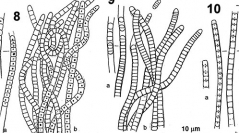

 Cryptogamie, Algologie
26 (3) - Pages 275-358
Cryptogamie, Algologie
26 (3) - Pages 275-358Algae and cyanobacteria occurring on monuments and other epilithic habitats in the Region of Murcia (SE Spain) were studied. Samples were collected from 16 subaerial sites, including monuments (12), calcareous rocks (3) and a new building (1); limestone and marble were the predominant substrata. Overall, 47 taxa were identified (22 cyanophytes, 4 heterokontophytes and 20 chlorophytes). In total, 58 unialgal strains were isolated. The following species were recorded for the first time for Spain: Cyanobacterium cedrorum (Sauv.) Komárek et Anagn., Nautococcus terrestris P.A.Archibald, Tetracystis sarcinalis Schwarz, Ecdysichlamys obliqua G.S.West, Oocystis asymmetrica W. et G.S.West sensu Komáromy, Chlorella kessleri Fott et Nováková, Klebsormidium nitens (Menegh. in Kütz.) Lokhorst, Klebsormidium crenulatum (Kütz.) Lokhorst and Stichococcus allas Reisigl. The most diverse genus was Leptolyngbya (7 taxa) and the most frequent taxa were Chroococcidiopsis kashaii, Nostoc sphaericum, Botrydiopsis sp., Apatococcus lobatus, Chlorosarcinopsis cf. arenicola, Muriella terrestris, Chlorella vulgaris, Chlorella kessleri and Stichococcus bacillaris. The epi- and (chasmo)endolithic flora from these sites showed a dominance of prokaryotic microorganisms and only the more humid sites were colonized by eukaryotic algae. The chasmoendolithic cyanophyte Chroococcidiopsis kashaii was dominant. The data showed that coccoid species outnumbered the filamentous species and represented 55 % of all taxa recorded. The type of lithic substratum is considered to have little or no influence on the composition of the lithic phycoflora in the localities investigated.